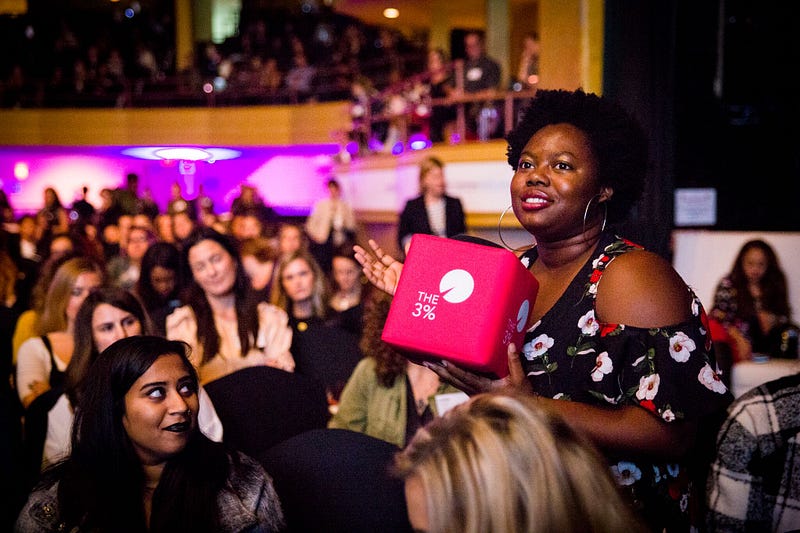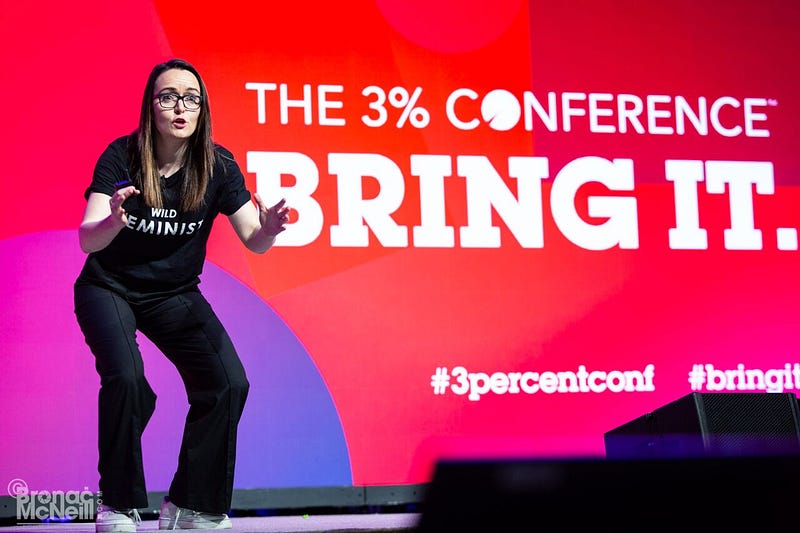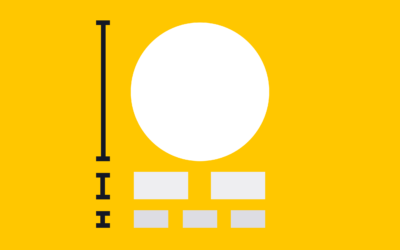The 3% Movement started as a passion project by Founder Kat Gordon to spotlight a huge business opportunity in advertising — the lack of female creative leadership and its impact on connecting with an overwhelmingly female marketplace. The first 3% Conference was held in 2012 — a time when just 3% of creative director roles in the ad world were held by women and even less by people of color — and has since grown to be one of the most celebrated industry events dedicated to changing the status quo and driving meaningful change. Today, in addition to its conference, 3% offers a certification program for agencies, MiniCon events throughout the year, consulting services, an online community of 40,000+, a student scholarship fund, and so much more.
Noun Project and 3% have joined forces to launch a new collection of stock photos that celebrate empowered women leading at work, at home, in their communities and beyond.
We spoke with 3% Founder Kat Gordon to learn more about The 3% Movement and how the conference has changed over the years, 3%’s new accelerator program for women of color, and her advice for how companies can support the rise of more women and people from underrepresented communities in leadership today.
Hi Kat! How did you get to where you are today?

Through a “create your own adventure” itinerary that started in New York City where I was born and involved many non-linear stops along the way. I was always running less towards something than running away from sameness and boredom. So I changed coasts (now in the Bay Area), careers (ditched the magazine business and now have worked at every variation of ad agency — in-house, huge agency, small agency, my own agency), and finally landed where I am now: living in Palo Alto and soon to have an empty nest, COVID-willing.
What inspired you to create 3% and its groundbreaking conference experience?
3% was a widely known figure about how many creative directors in advertising were women. I was part of that small representation. It started to irk me that this number was just accepted as “the way things are.” Especially because I knew that the majority of consumer buying decisions were made by women. Why were brands speaking to women (and multi-ethnic, multi-cultural women) through ideas that sprung mostly from the heads of white men?
3%’s annual conference has become an important gathering for people in the agency world and the clients they serve. The 3% Conference is now in its 9th year – what are some of the key changes you’ve seen over the last decade? How has the conference and the topics it tackles changed?
This past year in particular marks a huge change. Once we realized that due to COVID we wouldn’t be able to convene a live event, we huddled as a team (along with our advisory board) and decided: let’s do a virtual event and make it so good that it challenges what virtual events even are. We were not interested in stringing together a bunch of zoom interviews and calling it an event. In late July we delivered a 3-day virtual event, themed “The Radically Inclusive Future of Work.” Just like we do at our live events, we approached this with a high bar for creative delivery: incorporating creative performances, a documentary screening and interview with the director, and audience engagement through live Q&A.
In terms of the topics we tackle, that is also something that changes yearly. As we get closer to parity with women as creative leaders, the vistas change. Our focus on an intersectional approach means that we spotlight ways that the workplace is still leaving certain talent behind. A central theme for this year’s conference was how to create truly anti-racist workplaces and we published a new list of microactions towards that goal. Everything we do has creativity as its center. And when all people feel true psychological safety and a sense of belonging, creativity explodes.

3% recently launched an accelerator for women entrepreneurs of color with a cohort of 9 entrepreneurs whose businesses are doing incredible work to solve real-world needs. Why did you decide to launch the program and what is the vision for this initiative?
The idea for the Accelerator came from our PR Lead, Nancy Vaughn. She shared it at one of our team retreats a couple of years ago and it was a lightning rod moment. One of those “we need to find a way to do this” certainties. The goal was to spotlight women of color — especially Black women — who have recently left the agency world to start their own creative businesses. The goal is to create community for these 9 women and to offer support through both visibility of their businesses and via guest speakers on a host of topics.
We’re about seven months in since its launch and I am amazed at this group. They each have very different dreams and goals, but seem unified by a belief that they will make a bigger impact out on their own than working inside the machine of Madison Avenue. The long-term goal is just like it was for the conference: communication through demonstration. Just show the brilliance and creativity of Black leaders as they build new and better ways of doing business. Open people’s minds up to the fact that incredible talent is leaving the industry and doing innovative things elsewhere, hopefully as a cautionary tale to change long-standing inequities and blind-spots.
What do you see as the biggest opportunities to drive meaningful change when it comes to recruiting, supporting and retaining diverse creative talent?
Have diverse creative leadership at the very top. Cultures of belonging, where people want to stay and contribute at the highest levels, can’t be manufactured. They’re a byproduct of leadership that reflects many different types of creators.
What are a few ways companies can champion more diversity on their creative teams?
State that it’s a value. Back it up with budgets for employee resource groups (ERGs) that serve diverse creators inside your company. Enter your diverse creatives’ work into award shows. Invite them into high-visibility pitches. Nominate them for industry awards. Pay everyone equally and ensure that you’re promoting diverse talent at the same rate as others on the team.
When you look to the future, what inspires you and what initiatives are you most excited about?
I’m really excited about 600 and Rising which recently launched to showcase the tremendous Black talent in the ad industry and to ask for changes to be made to remove long-standing obstacles. There is power in numbers and seeing the 600 signatories of their letter to holding companies gave me chills. This is how change happens.
How can people support the work you’re doing?
Watch our conference online! It’s just $99 and the content is up to watch and revisit until the end of 2020. Students come free. Once you’ve seen up close what we’re about, get more involved. Write for our blog. Follow our social posts and newsletters. Share our research. And convince your company’s leadership to turn to us for culture assessment and change. We’ve got everything from a Pledge for Pay Equity to a Certification Program and workshops for men as 21st Century allies and hiring managers to eradicate Creativity Bias.

About The 3% Movement
Started to spotlight a huge business opportunity in advertising — the lack of female creative leadership and its impact on connecting with an overwhelmingly female marketplace — The 3% Movement has grown exponentially since its 2012 launch. Hosting events in 27 cities globally and offering consulting and certification programs that amplify creative cultures, 3% has helped drive the number of female creative directors in the U.S. from 3% to 29%.





